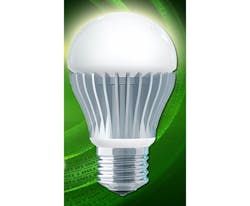A recent discussion with Scott Brown of iWatt revealed some interesting facts about the design of IC drivers for consumer LED lighting. Although LED lifetime can reach about 20 years and the power consumption will be less than the incandescent lamp it replaces, the LED bulb's overall cost must also be factored in.
Cost is the key issue governing the design of the present generation of LED lighting for consumer use. The bill of materials (BOM) must be low enough to compete with incandescent lamps in terms of lifetime and power consumption. This includes the LED driver IC and its external components that are packaged inside the LED bulb. One example is the cost of the power transistor in the LED driver. In iWatt's case, they chose to employ a BJT driver instead of a more expensive power MOSFET. Price pressure also impacts the choice of power factor correction (PFC) required to meet PF regulations and mandated minimum power line harmonics. A traditional PFC circuit requires two-stages. Although a simpler single-stage technique lowers the cost, it can increase ripple current that causes objectionable flicker. Therefore, a single-stage design involves an inherent trade-off between power factor and output ripple. However, it is possible to design a single-stage PFC that provides adequate power factor and relatively low output ripple, minimizing both heat and flicker, with little impact on overall cost or size.
LED bulb operating temperature is another cost consideration, particularly for residential use where the bulb may be in a location with little or no cooling. This requires some form of over-temperature protection (OTP) to protect internal bulb circuits.
There is also a choice between isolated and non-isolated LED drivers. Isolated types require a transformer, whereas the non-isolated version eliminates that cost. However, the non-isolated driver incurs other costs because it requires heavier insulation and a more costly mechanical enclosure.
Brown said that iWatt's initial consumer products were intended for non-dimming applications. After the company received a patent (8,222,832) in July 2012 describing adaptive dimmer detection for an associated triac phase-control dimmer, they developed LED driver ICs with dimming capability.
The patent states:
"An LED lamp is provided in which the output light intensity of the LEDs in the LED lamp is adjusted based on the input voltage to the LED lamp. A dimmer control unit detects a type of dimmer switch during a configuration process. Using the detected dimmer type, the dimmer control unit generates control signals appropriate for the detected dimmer type to provide regulated current to the LEDs and to achieve the desired dimming effect. The LED lamp can be a direct replacement of conventional incandescent lamps in typical wiring configurations found in residential and commercial building lighting applications that use conventional dimmer switches."
Even adding dimming, Brown said there are several ways it can impact LED lighting, for example:
· Drop-out
When the lighting control is moved to the bottom of its dimming range the light goes out before it reaches the end of travel.
· Dead travel
When the lighting control is moved up from its lowest position, there is no change in light level until it pops on.
· Pop-on
Light does not turn on at low dimmer levels. Then, raising the dimmer level causes the light to suddenly turn on.
· Popcorning
This occurs when bulbs in multiple-light installations are on the same dimmer circuit and they turn on at different dimmer settings.
Brown noted that iWatt has been able to avoid these problems with two new SSL LED driver types, the iW3606 rated at 8W and the iW3608 rated at 15W:
· 1% to 100% dimming range
· Pop-on current < 5% of light output
· Virtually no dead travel
· No popcorning
· No drop-out Overall LED lighting performance
· Reduced BOM Costs
· Up to 40% less for the iW3606 and up to 20% less for the iW3608
· LED driver uses BJTs instead of power MOSFETs
· Minimum number of EMI filtering components
· BJTs and valley mode switching lowers EMI
· Protection
· Output over-voltage protection (OVP)
· Output short circuit protection (SCP)
· Configurable over-temperature protection (OTP) and derating
· Primary sense resistor short protection
· High power line quality
Power Factor >0.92
THD <20%
· Optimized circuit
Primary-side control
No secondary-side regulator
No optical feedback isolator
No external NTC resistor
No high-voltage electrolytic capacitors
82% efficiency
Configurable Over-temperature Protection (OTP)
Both the iW3606 and iW3608 employ a sophisticated closed-loop circuit that monitors temperature inside the LED bulb without the need for an NTC resistor. If the temperature rises above a pre-set threshold, the IC reduces LED current, lowering power dissipation and reducing heating. Current will continue to reduce until the LED bulb reaches its threshold temperature. The small reduction in current drive produces negligible light reduction. However, in extreme situations the IC can reduce LED current to zero.



